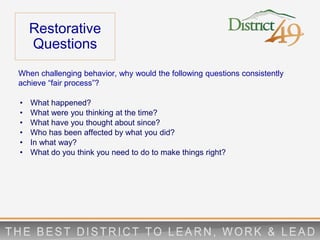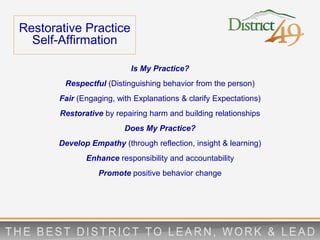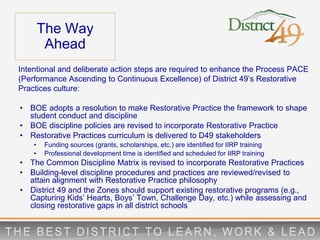Restorative Practices Overview December 2015
- 1. Restorative Practices Overview Special Thanks to: Dr. Kim Boyd Ms. Liz Dalzell-Wagers Mr. Ron Hamilton Mr. David Watson The D49 RAMP Council The D49 DAAC
- 2. THE GOAL OF RESTORATIVE PRACTICE IN SCHOOL COMMUNITIES To manage conflict and tensions by repairing harm and strengthening relationships as a way of building community. - Les Davey, Director-IIRP United Kingdom
- 3. What Restorative Means ŌĆó Restorative means ŌĆśmaking things new againŌĆÖ ŌĆó What do you need to do to ŌĆśrestoreŌĆÖ your relationship if you hurt somebody or make that person feel negative emotions? ŌĆó To be ŌĆśrestorativeŌĆÖ you need to be accountable, not repeat the behavior, and make things right through dialogue with the goal of building or maintaining relationships.
- 4. Relationships and Learning Basic Concepts: ŌĆó Good relationships are the basis for learning ŌĆó Anything that affects relationships [such as inappropriate behavior] impacts learning ŌĆó Challenging inappropriate behavior needs to be experienced as an opportunity for learning
- 5. Shaping Mindset: Growth or Fixed ? ŌĆ£Learning is enhanced by challenge and is impeded by threat.ŌĆØ - Terry OŌĆÖConnell, Director-Real Justice Australia As a society, when someone does the wrong thing, what is the typical response?
- 6. Blame & Punishment What is the first question we ask when someone does the wrong thing? If we ask ŌĆ£whyŌĆØ, what answers do we expect to get? What is the problem with the ŌĆ£whyŌĆØ question? How does blame impact learning?
- 7. Simple Contrast Adversarial (Blame) approach: ŌĆ£What happened, who is to blame, what punishment or sanction is needed?ŌĆØ Restorative approach: ŌĆ£What happened, what harm has resulted and what needs to happen to make things right?ŌĆØ
- 8. Adversarial Focus is in the past Preoccupied with blame Deterrence linked to punishment Restorative Focus in past, present & future Emphasis on resulting harm Deterrence linked to relationships and personal accountability ŌĆśConsequences [may include punishment] are an important part of Restorative Practice. This involves dialogue and respectful challenge.ŌĆÖ So, what does Restorative Practice look like? Dialogue
- 9. Restorative Practices Include: ŌĆó Being respectful and fair ŌĆó Repairing harm ŌĆó Restoring and building relationships ŌĆó Developing empathy ŌĆó Promoting positive behavior change Restorative Practice Checklist
- 10. THE BEST DISTRICT TO LEARN, WORK & LEADTHE BEST DISTRICT TO LEARN, WORK & LEAD Strategy Culture Brand Who We Are
- 11. THE BEST DISTRICT TO LEARN, WORK & LEADTHE BEST DISTRICT TO LEARN, WORK & LEAD LOW HIGH HIGH TO WITH NOT FOR Punitive ŌĆ£Fixed MindsetŌĆØ (Authoritarian) Restorative ŌĆ£Growth MindsetŌĆØ (Authoritative) Neglectful ŌĆ£Fixed MindsetŌĆØ (Irresponsible) Permissive ŌĆ£Fixed MindsetŌĆØ (Paternalistic) Accountable & Transparent (challenge) Adapted from Social Discipline Window - Paul McCold and Ted Wachtel - 2000 Respectful & Caring (support) How We Treat Each Other
- 12. THE BEST DISTRICT TO LEARN, WORK & LEADTHE BEST DISTRICT TO LEARN, WORK & LEAD Compass of Shame WITHDRAW AVOID ATTACK SELF HATE Adapted from NathansonŌĆÖs Compass of Shame - 1992
- 13. THE BEST DISTRICT TO LEARN, WORK & LEADTHE BEST DISTRICT TO LEARN, WORK & LEAD Restoration versus Shame
- 14. What needs to happen for a fair process to be experienced? Engagement: Opportunity to have a say Explanation: Understand the reasons for the decision Expectation Clarity: Shared understanding on what is expected in terms of behavior and rules Kim & Mauborgne, Harvard Business Review, July ŌĆō August 1997 Fair Process
- 15. ŌĆó Trust ŌĆó Commitment ŌĆó Cooperation This enhances learning, creativity, moral development and helps build stronger relationships Kim & Mauborgne, Harvard Business Review, July ŌĆō August 1997 What Fair Process Achieves
- 16. When challenging behavior, why would the following questions consistently achieve ŌĆ£fair processŌĆØ? ŌĆó What happened? ŌĆó What were you thinking at the time? ŌĆó What have you thought about since? ŌĆó Who has been affected by what you did? ŌĆó In what way? ŌĆó What do you think you need to do to make things right? Restorative Questions
- 17. Is My Practice? Respectful (Distinguishing behavior from the person) Fair (Engaging, with Explanations & clarify Expectations) Restorative by repairing harm and building relationships Does My Practice? Develop Empathy (through reflection, insight & learning) Enhance responsibility and accountability Promote positive behavior change Restorative Practice Self-Affirmation
- 18. Intentional and deliberate action steps are required to enhance the Process PACE (Performance Ascending to Continuous Excellence) of District 49ŌĆÖs Restorative Practices culture: ŌĆó BOE adopts a resolution to make Restorative Practice the framework to shape student conduct and discipline ŌĆó BOE discipline policies are revised to incorporate Restorative Practice ŌĆó Restorative Practices curriculum is delivered to D49 stakeholders ŌĆó Funding sources (grants, scholarships, etc.) are identified for IIRP training ŌĆó Professional development time is identified and scheduled for IIRP training ŌĆó The Common Discipline Matrix is revised to incorporate Restorative Practices ŌĆó Building-level discipline procedures and practices are reviewed/revised to attain alignment with Restorative Practice philosophy ŌĆó District 49 and the Zones should support existing restorative programs (e.g., Capturing KidsŌĆÖ Hearts, BoysŌĆÖ Town, Challenge Day, etc.) while assessing and closing restorative gaps in all district schools The Way Ahead
- 19. Questions?


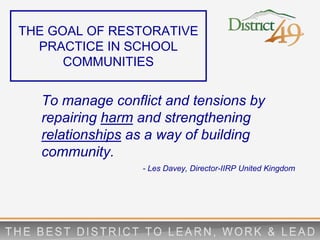
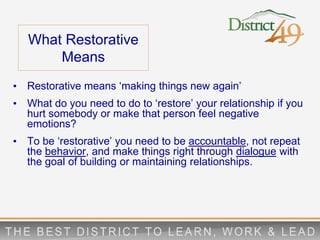
![Relationships
and Learning
Basic Concepts:
ŌĆó Good relationships are the basis for learning
ŌĆó Anything that affects relationships [such as inappropriate
behavior] impacts learning
ŌĆó Challenging inappropriate behavior needs to be
experienced as an opportunity for learning](https://image.slidesharecdn.com/f00f8def-b1bb-4811-b771-7de6deca45f7-160119182324/85/Restorative-Practices-Overview-December-2015-4-320.jpg)



![Adversarial
Focus is in the past
Preoccupied with blame
Deterrence linked to
punishment
Restorative
Focus in past, present & future
Emphasis on resulting harm
Deterrence linked to relationships and
personal accountability
ŌĆśConsequences [may include punishment] are an important part of Restorative Practice. This
involves dialogue and respectful challenge.ŌĆÖ
So, what does Restorative Practice look like?
Dialogue](https://image.slidesharecdn.com/f00f8def-b1bb-4811-b771-7de6deca45f7-160119182324/85/Restorative-Practices-Overview-December-2015-8-320.jpg)







